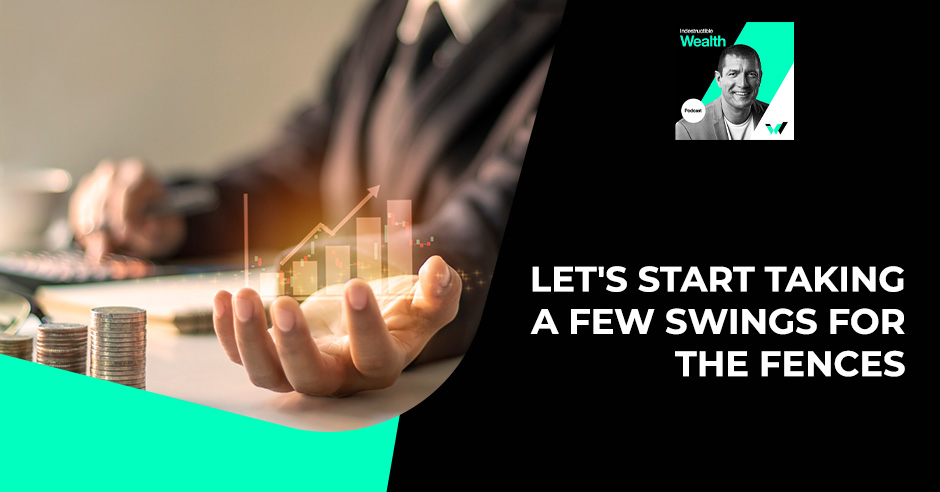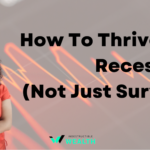
To create wealth, we need to start positioning ourselves in front of these trends and the early stages before these technologies are mass adopted. To do that, we will have to take on some risks. In this episode, Jack Gibson breaks down the symmetry of investing, wealth building, and taking calculable risks.
—
Table of Contents
Listen to the podcast here
Let’s Start Taking A Few Swings For The Fences
Back in the year 2000, I bought my first cellular phone. It was a flip-open phone, and texting was arduous when you had to use the numbers on the telephone to find the letters. Does anybody remember that? In less than a few decades, we now have not phones but computers in our pockets that are 100,000 times more powerful than the computer NASA used to send the first astronauts to the moon.
What will happen over the next decade with technological advances will simply be mind-boggling. Autonomous cars, gene editing therapy, biotechnology breakthroughs, 5G and 6G super speed wireless networks, and robotics, including personal assistance, are a handful of the exponential advances we are on the cusp of seeing in our everyday lives.
To create wealth, we want to be picking Netflix and not Blockbuster. We want Amazon and not shopping malls. We want Google and not AOL. We need to start positioning ourselves to be in front of these trends in the early stages before these technologies get mass-adopted. In order to do that, we will have to take on some risks. The key is keeping that risk a smaller part of our portfolios until we build up some safe, stable, passive income streams.
In this episode, we will cover step four and take some small swings for the fences that don’t knock us out of the game but position us for some potentially huge upside. This is where it starts to get fun, and you get to flex your entrepreneurial risk-taking spirit.
—
I’m super excited that you decided to join me. I’m feeling good, nice, limber, and loose. I got a 90-minute sports medicine massage. I told her I almost felt funny about it. She was like, “Are you pursuing any athletic-type endeavors? I’m like, “I’m trying to get better at golf.” I was hoping she didn’t laugh. I do need to get better at golf because every time I play well, which is not that often, it is like poetry and motion. It is fun.
I got to get more flexible. I’m super tight. My lower back is starting to get strained because I need to stretch more. I’m like, “Should I do yoga? Does anybody out there like yoga?” How do you like yoga? Sitting there for an hour and not being able to do something productive and stretching sounds awful. She stretched me out. I will spend money on massages. I think that is a great investment. I want to create more money so I can get even better massages. This girl was good. She went to work. I’m good, loose, and limber.
Allocating Your Investments
Are you ready because we are going to talk about taking some small reasonable swings for the fences? This step is number four in the seven-step series. It is titled Allocate a Portion of Your Investments into Well-Researched High Reward Plays Using Small Amounts That You Can Risk. I’m going to set this up. Over the past several years, after going through some shady stock market manipulations, I had a couple of stocks where these big Wall Street hedge fund guys came in and shorted the stock I was in, and my stock dropped like a rock. I decided to learn, study and implement a cashflow investing strategy.
I became focused on it that I ignored anything that could even be considered the least fit speculative. I got out of stock. I was pissed. That wasn’t the right move at all. I was angry that people could come into a market like that where I have no control, and they could manipulate the market and causes a stock to go down. I wanted to only buy investments that I knew when I bought them what the return on investment would be. I started buying cashflow-producing real estate. Everything I do when I make up my mind, I get hyper-focused, and to my own detriment, I often can’t see anything else. They call that tunnel vision.
For a couple of hours per week, I worked and held my wife out at our little nutrition club, whipping up high-energy teas and healthy smoothies for customers. This guy, Lance, the landscaper, comes in. I have known Lance for several years. He has been a regular, and we are in the same entrepreneurial group. He is a nice guy. I know, based on conversations at the entrepreneurial club, that he had some significant struggle struggles in his landscaping business. Mainly with employees attracted in keeping solid, hardworking, loyal people in that business is tough. Lance was consistently feeling the same pain.
We got into a conversation about Bitcoin and cryptocurrency. I was starting to get into it and hear more about it. Lance told me that he bought ten Bitcoin back when it was $1,000 per coin. It was at $20,000 when we had that conversation. Thereafter, it jumped to as high as $64,000. It sits, as of this recording, at $54,000 per coin.
Lance, the struggling landscaper, took $10,000. We call that a stack of high society. I learned that from Rounders with Matt Damon in the poker movie. He talked about it when he went in, and he grabbed three stacks of high society. He went into the illegal underground poker game, and he lost it all. I have never done that, but he turned $10,000, and it is now worth over $540,000.
It’s Time To Change Your Mindset
I knew right then and there that I had to change my mindset. It was time to start going after some exponential returns. I could have peeled up $10,000 and bought some Bitcoin. I could have easily done that. I peeled up $10,000 and went and played in the World Series of Poker. I lost all that in ten hours. I played in the main event, which was a dream. It was okay. It was a dream come true, and I don’t regret it. It was awesome. I got it stuck to me in that last hand I was in. I still feel bitter about that. I can’t talk about it right now, but I knew it was time to stop grinding out only small and predictable returns. I need to start doing and making some higher risk, higher reward places.
It’s time to change your mindset and start going after some exponential returns. Share on XI didn’t rush to go out, rush out and buy Bitcoin when it was at an all-time high. I started learning and studying the market. FOMO, which is an acronym for Fear Of Missing Out, is a terrible emotion for investors. That got me back in 2000 when I had saved up $50,000 while I was going to college. I invested it all in the tech stocks because other investors were getting 30% to 40% annualized returns in tech stocks. I thought, “I don’t want to miss out on this.” I buy in at the market peak. I lose half my money. I didn’t want to repeat that error in judgment. We are going to learn anything from the mistakes of our past. Let’s not repeat them.
FOMO causes us to buy things when they are sitting at peaks instead of buying things when they are on sale. I started doing research. I subscribed to some experts. I paid a few grand to experts who study crypto. I have insider information and research teams who have been doing it for years. I finally humbled myself and said, “Follow their advice. They know a lot more about this than you.” I followed the suggestions. I spread my allocation across multiple coins. There are Bitcoin and altcoins. Altcoins are Alternative Coins. That is everything but Bitcoin.
That Day Is Coming
I pretty much went into it that I’m going to be prepared to hold for 5 to 10 years, waiting for this to get into mass adoption where we are using blockchain technology in our everyday life. I do believe that is coming, where our entire day will be multiple occurrences of blockchain and cryptocurrency usage. It will happen within the next decade, probably much faster than that. I can guarantee that it is coming.

Taking Calculable Risks: The day is coming when our entire day will be multiple occurrences of blockchain and cryptocurrency usage. It will happen within the next decade, probably much faster than that.
I didn’t have to wait very long. Within a month, my portfolio was up over 100%. It is very volatile. It can swing quite a bit from even one day to the next. Last time, I lost over $100,000 in crypto overnight. Don’t play the violin. That was a portion of my gains. One week later, it is all back. I didn’t care when it happened because I knew that it was a temporary downswing. It is a small percentage of my overall portfolio, but it has a chance of growing exponentially. I call it parabolic.
If all of my cryptos go to zero, which is unlikely, the greater chance is that it is hacked and stolen, my cashflow-producing investments will replace everything I have put into crypto within about a year. I have one coin, Uniswap. I love this coin. I don’t know if I will rush out and buy it. I’m not telling you to do that because when I bought it, it was at $3, and as of now, it is at $41. According to my chart, I’m up 990% on Uniswap.
Uniswap is like Coinbase, where you can buy and sell crypto, but it is a decentralized exchange. I like the concept. That made sense to me. That is one of the ones that I bought, and it was also recommended to me. A 990% increase on that one coin in about four months. There are lots of plays in the stock market that we can also use the same strategy to go for big gains.
Asymmetric Bet Versus Symmetric Bet
I can’t say that I’m taking huge risks, but I’m going for what is called asymmetric gains. Let’s think about the difference between a symmetric and an asymmetric bet. Symmetry is where you have an equally divisible amount on one side or the other. When somebody is said to have symmetry in their looks, they are generally going to be better looking because you have equal symmetry and balance in your features.
In this case, a symmetric bet is where you put in $100, and you are going for these $5 to $10 type gains. In a symmetric bet, the upside is about equal to the downside. We have seen it happen. The stock market dropped by 50% back in 2008. Last March 2020, when COVID hit, the market dropped 30%. You can see some big downward drops. You could also see some 50% gains in the stock market.
Symmetric bets are typical for high cash value, whole life, real estate, mortgage, back notes, and mutual funds, which historically hit around 6%. Symmetric bets overall are less volatile. They tend to be safer. Typically, there is not a huge risk to your capital. I would argue the point that mutual funds, for their average annual returns of 6%, are probably the riskiest of all those available options because they can drop in value quickly.
In asymmetric bets, this is where we will start doing it in this step. This is where you put in $1, and you are going for $100, even $1,000. This is the Uniswap bet. This is Lance’s bet on Bitcoin. These are small bets that have a chance of going parabolic. These types of plays typically sound too good to be true for most people. That is the way I was too. I was like, “This only happens for other people. This is never going to happen for me. I’m going to pay, place the bet, and I’m going to lose it all.”
You don’t even open up your mind to the possibility that this can happen for you. I was that guy. I can understand and relate. My two biggest thoughts were, “That only happens for others that get lucky.” Two, “I don’t have the time, patience, or research abilities to sift through and analyze the thousands of potential asymmetric opportunities out there and somehow throw a dart at the dartboard and pick the right investment.”
Here is the thing. You don’t have to do the research and spend the time and have the patience to analyze thousands of opportunities. There are smart guys who do this every day that spend all day, every day, looking at potential options and pass that information on to you. They have proven track records of being able to make picks that provide monstrous type gains. They have 150-person research teams that do the heavy lifting.
You don't have to do the research and spend the time to analyze thousands of opportunities. Intelligent people do this every day, looking at potential options and then passing that information on to you. Share on XWhat are these? Who are these people? How do I find them? They are out there. There are plenty of options. These are what are called paid subscription models or newsletters. Does every pick they make go parabolic? Of course not. You don’t need them to. Oftentimes, you only need them to be right 1 out of 10 times, but they are right a lot more than 1 out of 10 times.
Let’s look at an example. You have been presented with ten well-researched early-stage companies that Wall Street hasn’t recognized yet and haven’t gone mainstream. This is how I love investing in the stock market. I want small companies that I understand what they are doing. I get their business model. I want a piece of the ownership of that company because when you buy a stock, it is an equity or share of ownership in that company. I want to get these companies that a lot of people aren’t even looking at yet.
You bet $1,000 in all 10 picks for a total of $10,000. After five years, nine of them drop in half. These are viable companies. It is not likely that they will go bankrupt and simply drop to zero. Certainly, in the equities market, this is not likely to happen, where they go to zero. These are businesses that do have some track record of sales, revenue, and infrastructure, but more likely, they would drop in value by a percentage.

Taking Calculable Risks: In the equities market, it is not likely to happen where they go to zero. In the crypto game, there are going to be a lot of projects that simply vanish and completely go to zero.
In the crypto game, there are going to be a lot of projects that simply vanish and completely go to zero. As this whole technology starts to play out, we will probably see it more in the crypto space than we will in the equities market. 1 of the 10 picks goes up 100X to $100,000. On your original $10,000 invested, you have a total value of $104,500. You got the $4,500 because the other nine dropped in half. There is your other $4,500, and you got $100,000 from the one that went 100X. That is a total return of 945%. If we look at it on a year-by-year basis, it is an annualized return on investment of 59%.
Asset Allocation Model
Being that the average mutual fund returns an actual annual return of around 5% to 6%, historically, I would say 59% is pretty darn good. What is critical to the successful inflammation of this strategy is the asset allocation model that I adamantly teach. You got your safe, steady, predictable, boring returns from your whole life cash value insurance policy. You got your mortgage back notes with the safe and predictable 6% to 9%. You got your real estate rental holdings that crank out 8%, 10%, and maybe as much as 20% with us utilizing leverage or debt. You got your syndication investments like the one I’m in with self-storage that hit 18%, 20%, 25%, and even 30%.
In addition, you got some equity, private businesses that you own, private money loans out there, blue chip dividend-paying stocks, and maybe you got some collectibles like sports trading cards or vintage cards with various rates of return. With those solid income-producing assets in play and diversification across all these different asset classes, you can comfortably aggressively take some swings for the fences with these asymmetric plays.
What is important is if you are following the seven steps strategic process here, you are clear on strategy over tactics. Strategy in any field, Trump’s tactics. Imagine the US military going to war and randomly sending in troops, tanks, and jet fighters without an overall strategic, coordinated plan to guide them simply because they have better tactics.
Their tactics are their advanced weaponry, highly skilled trained fighters, and overall superior technology. Those are the tactics. No matter how superior the tactics, without a guided strategic plan, we all know this could go into battle on tactics. Probably, it will be a total disaster. The same thing applies to your financial plan. You get to know and understand your strategy and the tactics, what you are buying within that strategy, like this will be one part of your overall efforts.
Take Gambles
I’m not telling you ever to risk your lifestyle for a better one. I’m not telling you to take gambles that you are not comfortable making that don’t make sense to you. When you follow my seven-step plan, you are never going to get knocked out of the game if you do it the right way. If you are up until age 30 or under, you could probably do 20% to 30% of your total portfolio of investible dollars. You could do it into these types of plays because you got a long time and a lot of earning power to recover. As you start hitting, you know, 40, 50, and 60, you want to start taking smaller percentages of your total portfolio to go after these types of riskier places because you don’t have as long to recover.
If you're up until age 30 or under, you could do 20%-30% of your total portfolio. As you start hitting 40, 50, or 60, you want to take smaller percentages of your total portfolio to go after these riskier places because you don't have as long to… Share on XI believe that with the amount of new technology in the biotechnology area, precision medicine, and gene therapy that is coming out, we are going to see the lifespans of the average American are going to skyrocket over the next couple of decades, over 100. That is likely to happen. You got even longer. When you are 40 or 50, and you have an expected lifespan of 100, you got a lot more time to take riskier, higher return-type bats.
I appreciate Lance. I wouldn’t say I’m jealous because we have an incredible life and plenty of resources. I’m kicking myself because I didn’t do what Lance did. I didn’t do this a few decades ago. I’m encouraging you guys to keep a balanced plan, and it is going to work out for you. I hope you got a ton of value on this episode. I can’t wait to share the next episode with you guys.
Important Links





